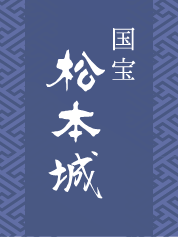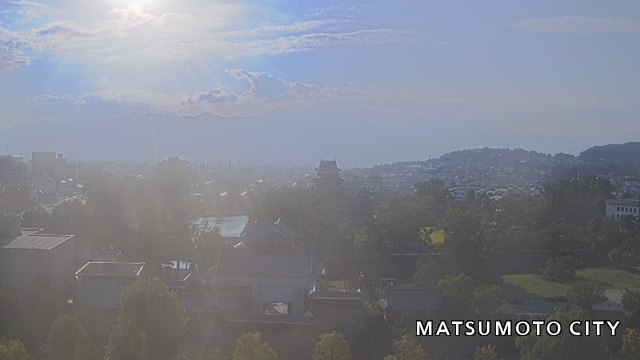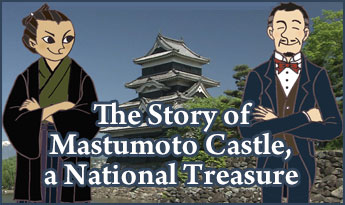Castle towns in Matsumoto
Origins of the town names
While there are many theories about the origins of the town names, we will introduce the one generated in the Edo period here. The source is "Matsumoto-ki" (included in "Matsumotoshi History" Vol.4, No.1) published in Kanbun 9 (1669).
Honmachi, Nakacho and Higashicho
They were named based on their locations (Honmachi due to the heart of the area, Naka-cho because it is located in the center of the area, and Higashi-cho as it is located in the east part of the area.)
Isemachi
This town used to be called "Nishiguchi" as it was located in the west, but was renamed "Isemachi" because people moved to here brought Ise Shrine.
Bakuromachi
The name was derived from the fact that many horse traders dealing with horses for tributes used to live and horse fairs were held here.
Iidamachi
The name came from the fact that Hidemasa Ogasawara, his warriors and craftsmen moved to Matsumoto from Iida.
Koikemachi
The name came from the fact that Jinnojo Koike, the servant of Ogasawara clan having excellent skills in military and tactics, used to live here.
Miyamuramachi
There was a village called "Shonaihonmachi,"but it was renamed "Miyamura" due to the transfer of Suwa Daimyo-jin.
Izumimachi
The name came from the fact that Izumi Kurashina, the servant of Ogasawara clan, used to live here.
Yasuharamachi
As the previous name was "Asabanohara," the first and last characters of this name were combined to create the current name.
Yokotamachi
The name was derived from the fact that people from Yokota village moved to this area.
Yamabekoji
The part of the name "Koji" came from the fact that the mountain roads linked to villages were quite narrow.
Tomisakamachi
The name came from the fact that eagle hunter Tomisaka clan and its subordinates called "esashi" used to live here.
Ogawamachi
The name was derived from the fact that eagle hunter Ogawa clan used to live here at the era of Mizuno clan.
Origins of the names of the towns where there were warrior residences
As there is no description on the towns for warrior residences in the source above, we will refer to another source "Matsumotoshi History" published in Showa 8 (1933) to summarize the names of residential areas for samurai warriors.
Daimyocho
The name was derived from the fact that warriors having high salaries called "hanshi" used to live here.
Yanagimachi
There were many willow trees in the town previously called "Doromachi."
Jizoshimizu
The name came from the fact that natural water came from springs from ancient times and there was a stone Jizo in this area when Shoanji Temple was in Doromachi.
Doijiri
The name was derived from the fact that the are was the end of the ditch in which water flew.
Aoinobaba
The name was derived from the fact that the flowers of Malva ("Aoi" in Japanese) were planted on the bank of horse-riding places.
Rokku
The name came from the fact that a stable for 54 horses was built in the area.
Agetsuchi
The name came from the fact that the soil was piled up due to digging ditches.
Kataha
The name was derived from the fact that the town was located in one side of the area facing the outer moats.
Deiban
The name was derived from the fact that people working at traffic offices called "kuchi-bansho" and guard stations called "Ikada-bansho" used to live here.
Fukuromachi
The name came from the fact that there was no exit in the north part of the town while there was an entrance in the south.
Shinmachi
The name came from the fact that the town was established at the era of Matsudaira clan.
Tamachi
The name was derived from the fact that the town was established in the area where there were rice fields.
Kami / Shimoumadashi
The name came from the road running from Umadashi to Higashicho.
Takajomachi
The name came from the fact that there was a residence where a warrior working with eagles used to live.
Hatamachi
The name was derived from the fact that the town was shaped like a flag ("hata" in Japanese).
Doumachi
The name was derived from the fact that there was a temple called "Myokoji" in the town.
Kobarimachi
The name came from the fact that there were Japanese red apricot trees in the town.
Tenpakucho
The name came from the fact that there was a shrine called "Tenpaku Shrine" in the town.
Hagimachi
The name was derived from the fact that there was a thorn hedge between the town and Zenkō-ji road.
There are other opinions regarding the origins of the towns. The sources also provides records about other towns which are not mentioned here. Please refer to source materials such as "Matsumotoshi History" published in Showa 8 (1933), "Folk customs and faith in Shinano and Matsumotodaira" by Iwao Tanaka published in Showa 39 (1964) and "Records of town names and residence indication in Matsumoto" published in Showa 44 (1969) to study the origins of other town names. Moreover, you can find stone pillars presenting the origins of the town names in the towns of Matsumoto.
If you want to check the inscriptions on stone monuments for town names, go to the Matsumotoshi official website "Kuru-kuru Net Matsumoto" and check "the list of previous town names" in "attractiveness of Matsumoto" section.








